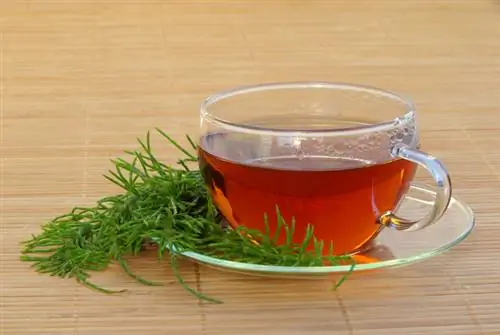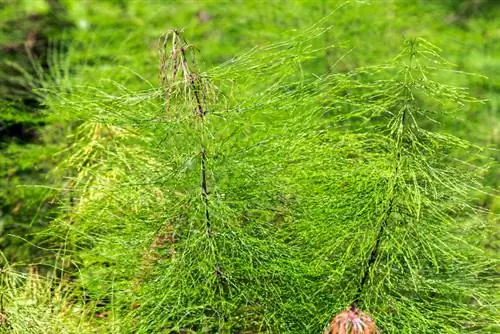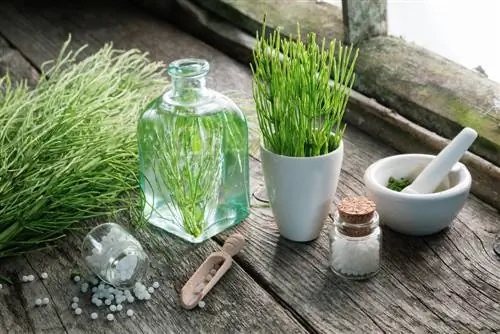- Author admin [email protected].
- Public 2023-12-16 16:46.
- Last modified 2025-06-01 06:02.
Field horsetail is one of the oldest plants ever. In the garden it is considered a weed because it is difficult to control. Due to its ingredients, horsetail enjoys great popularity in natural medicine, cosmetics and as an ecological fertilizer and plant protection. A profile.

What is field horsetail and what properties does it have?
Field horsetail (Equisetum arvense), also known as horsetail, is an ancient plant that is used in naturopathy, cosmetics and organic gardening. The plant contains silica, minerals and essential oils and is suitable for treating rheumatism, gout or inflammation.
Field horsetail - a profile
- Botanical name: Equisetum arvense
- other names: horsetail, panwort, scrubweed, cat's tail, ponytail
- Plant family: Horsetail family
- Botanical family: Ferns
- Occurrence: Northern Hemisphere
- Height: up to 50 cm
- Location: compacted soils, indicator plant for high groundwater levels
- Reproduction: spores, underground runners
- Flowering / flowering time: no flowering, spores bloom from May
- Use of natural remedies: rheumatism, gout, sore throat, inflammation
- Use in the garden: fertilizer, pesticides
- Ingredients: silica, minerals, essential oils
One of the oldest land plants ever
Field horsetail comes from horsetails, which have been around the world for around 400 million years. It is believed that the plant already existed on the ancient continent of Gondwana.
Based on fossil finds, it is likely that the original species could reach heights of up to 30 meters.
Visual appearance of the field horsetail
Outwardly, field horsetail resembles a coniferous plant. The rungs consist of tube-like sections that appear to be nested one on top of the other.
Field horsetail, like all ferns, does not develop flowers but instead develops spore ears. They appear first from March to May and then retreat into the ground. The leaves of the field horsetail then grow, which are green in color.
Field horsetail is not poisonous, unlike swamp horsetail (Equisetum palustre), which is particularly dangerous for grazing animals. You should therefore only pick field horsetail in nature if you are completely sure. Unfortunately, the two species can only be distinguished by a few characteristics.
Use of horsetail in naturopathy
Field horsetail can not only be used in the garden as fertilizer or plant protection, the herb also has a permanent place in natural medicine. It contains, among other things:
- Silica
- Saponins
- Minerals
- essential oils (camphor oil)
The herb is recommended dried or fresh for inflammation, rheumatism, gout and osteoarthritis, among other things.
Tip
The field horsetail owes its name to the fact that it used to be used to clean and polish tin dishes. The silica crystals contained in the herb have a rough consistency and dissolve even stubborn dirt residues.






